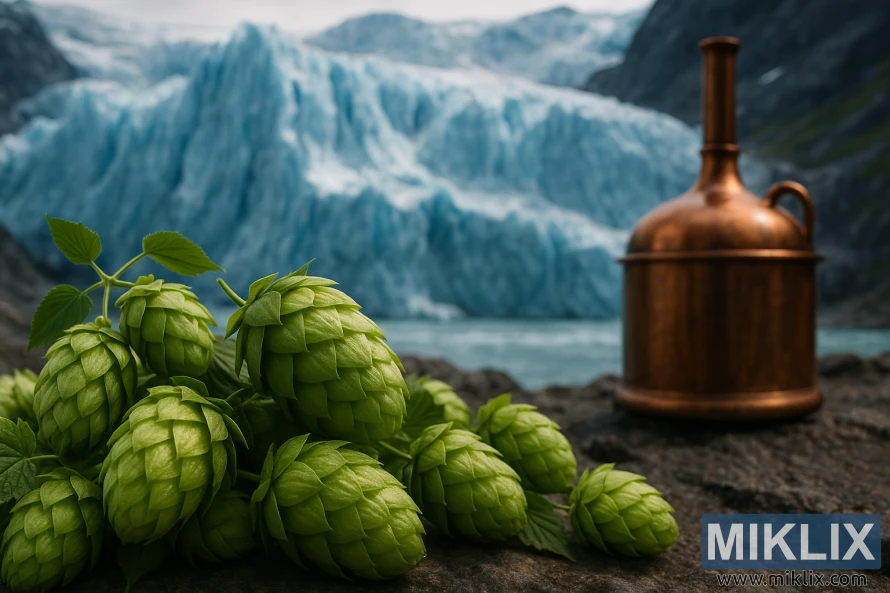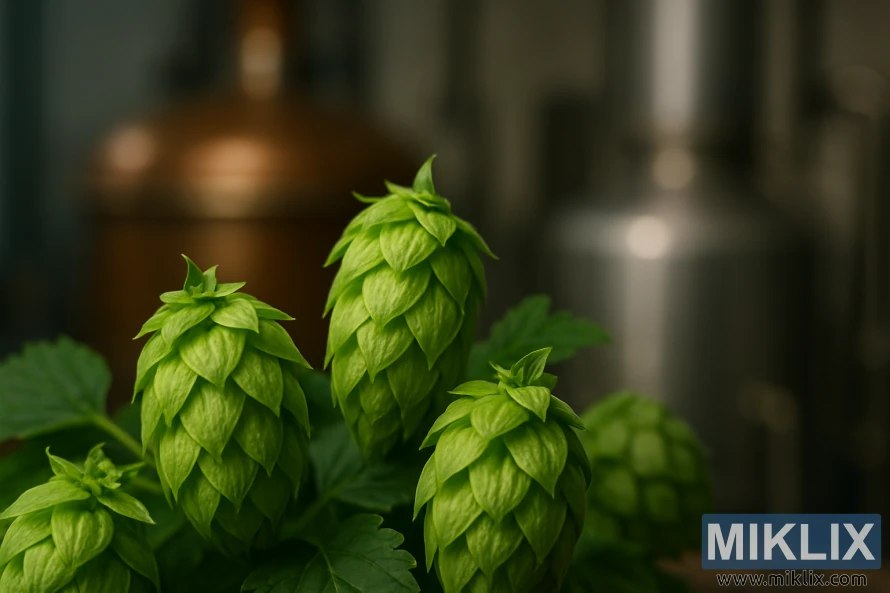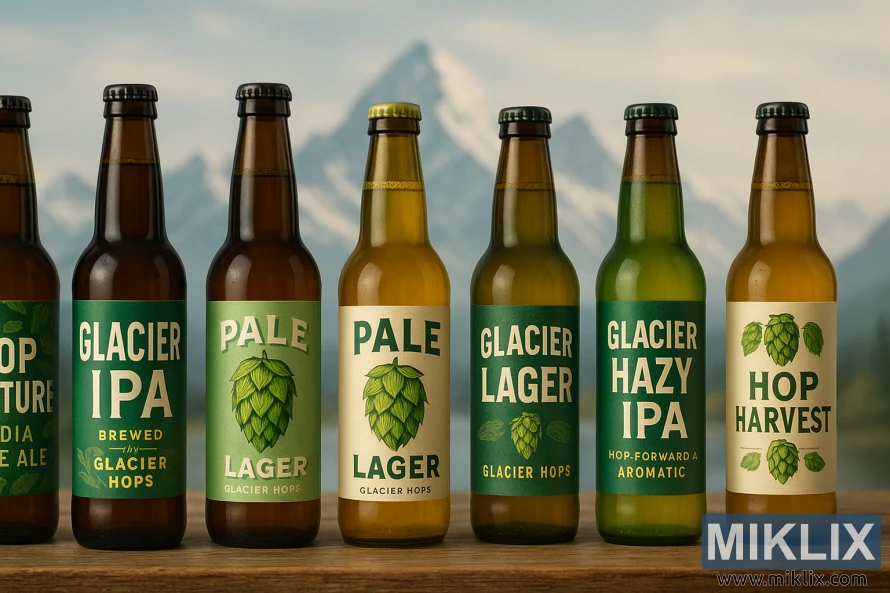Hops in Beer Brewing: Glacier
Published: July 29, 2025 at 7:39:10 AM UTC
Glacier hops, a creation of Washington State University, have become a cornerstone in the brewing world. Introduced in 2000, they stand out as a dual-purpose hop. This versatility allows brewers to use them for both bittering and adding flavor/aroma to their brews. Their ancestry, which includes the French Elsaesser hop, Brewer's Gold, and Northern Brewer, gives them a unique flavor profile. This blend of traditional and modern traits makes Glacier hops a favorite among both craft brewers and homebrewers.

Key Takeaways
- Glacier hops are a versatile dual-purpose hop variety.
- They were developed by Washington State University and released in 2000.
- Glacier hops offer a unique blend of traditional and new-world characteristics.
- They are suitable for both bittering and flavor/aroma purposes in beer brewing.
- Glacier hops are a popular choice among craft brewers and homebrewers.
Understanding Glacier Hops: Origins and Development
In 2000, Dr. Stephen Kenny introduced Glacier hops, marking a leap in hop cultivation. Developed at Washington State University, these hops combined traits from the French Elsaesser, Brewer's Gold, and Northern Brewer. This blend aimed to create a hop with both old-world charm and modern resilience.
Glacier hops stand out for their unique mix of characteristics. They offer high yields and resistance to disease, appealing to both commercial and homebrewers. This was a strategic move to craft a hop that could adapt to the brewing industry's changing demands.
Glacier hops have found their place in a variety of beer styles. Their introduction highlights the continuous evolution in hop cultivation and brewing techniques.
Dr. Kenny's breeding program focused on improving hop varieties. It aimed to boost disease resistance and alpha acid content. Glacier hops are the result of this research, giving brewers a premium hop choice.
Exploring the origins of Glacier hops helps brewers value their contribution to beer. Whether for bitterness, flavor, or aroma, Glacier hops enhance many recipes.
Essential Characteristics of Glacier Hops
Glacier hops are celebrated for their balanced properties, fitting well into a variety of beer styles. They boast a moderate alpha acid content, spanning from 3.3% to 9.7%. This range enables brewers to craft beers with a balanced bitterness, complementing diverse flavors.
The alpha acid in Glacier hops not only adds bitterness but also enriches their smooth, enjoyable taste. This makes them a top pick for brewers aiming to enhance depth without dominating other ingredients. Their high beta acid content also boosts their flavor and aroma.
The key traits of Glacier hops include:
- Moderate alpha acid content (3.3% - 9.7%)
- Smooth and pleasant bitterness
- High beta acid content contributing to flavor and aroma
- Versatility in various beer styles, from pale ales to porters and stouts
These attributes make Glacier hops a favorite among brewers. Their balanced nature allows for a broad range of uses, solidifying their value in many beer recipes.
Chemical Composition and Alpha Acid Content
Glacier hops have a distinct chemical makeup, with a mix of alpha and beta acids that brewers find appealing. Their chemical profile is marked by a moderate alpha acid content and a high beta acid content.
The alpha acid content in Glacier hops varies from 3.3% to 9.7%, averaging at 5.5%. This range allows brewers to pick the right batch for their recipes. Beta acids, on the other hand, span from 5.4% to 10%, averaging at 7.7%.
- Alpha acid content range: 3.3% - 9.7%
- Average alpha acid content: 5.5%
- Beta acid content range: 5.4% - 10%
- Average beta acid content: 7.7%
The blend of alpha and beta acids in Glacier hops enhances their flavor and aroma. This makes them a top pick for many beer styles. The right balance of these acids is key to achieving the perfect brew.
Knowing the chemical makeup and alpha acid levels of Glacier hops helps brewers craft beers with depth and balance. This knowledge is essential for creating complex and well-rounded brews.
Aroma and Flavor Profile
Glacier hops are celebrated for their mild bitterness and balanced flavor. They offer a versatile aroma and taste that fits many brewing needs. The aroma is earthy and woody, with a fruity hint. Their flavor is smooth and clean, ending with a crisp finish.
Glacier hops are perfect for a variety of beers, from pale ales to stouts. They bring subtle citrus, floral, and herbal notes. These add depth without dominating the beer's taste.
Using Glacier hops in brewing means you get a consistent flavor and aroma. This predictability is key, helping brewers refine their recipes. Whether crafting a hop-forward IPA or a complex porter, Glacier hops enhance the beer's character.
Best Beer Styles for Glacier Hops
Glacier hops offer a balanced mix of alpha and beta acids, making them versatile for various beer styles. This versatility is a boon for brewers aiming to craft complex, flavorful brews.
These hops are a perfect match for pale ales, IPAs, porters, and stouts. Their moderate bitterness and distinct flavor enhance these styles, adding to their character. Glacier hops are also favored for English-style ales, like ESBs and English pale ales, where their subtle hop taste is valued.
Glacier hops' adaptability empowers brewers to explore different beer styles, leading to the creation of unique, tasty brews. Some notable examples include:
- Pale ales
- IPAs
- Porters
- Stouts
- ESBs
- English pale ales
By using Glacier hops, brewers can infuse their beers with depth and complexity. This makes their brews stand out in a crowded market.
Optimal Growing Conditions
To successfully grow Glacier hops, farmers must grasp the best growing conditions. Known for their hardiness and adaptability, Glacier hops fit well in various climates. They flourish most in moderate climates with warm summers and cool winters.
Glacier hops need well-drained soil and full sun, making the Pacific Northwest an ideal place for them. The soil's pH should be between 6.0 and 7.0 for optimal growth. It's also important to prevent waterlogged soil to avoid root rot and diseases.
For climate, Glacier hops do best in a moderate environment. Warm summers help in developing alpha acids and essential oils. Cool winters, on the other hand, provide the necessary dormancy. This balance is essential for high-quality hops.
When growing Glacier hops, farmers should also consider soil quality, moisture levels, and sunlight. Optimizing these conditions can significantly improve the yield and quality of Glacier hops.
Harvesting and Processing Methods
Glacier hop harvesting is a meticulous process that affects the final beer product. Typically, Glacier hops are ready to be harvested in late August or early September. This is when the cones are fully mature and dry. The harvesting process involves cutting the hop vines and removing the cones. These are then dried to preserve their flavor and aroma.
The drying process is critical, as it helps to prevent spoilage and retain the hops' essential oils. After drying, Glacier hops are processed into various forms. This includes pellets and whole hops, making them versatile for different brewing applications.
The processing methods for Glacier hops include pelleting and packaging. These are designed to preserve the delicate flavor and aroma compounds. Proper processing ensures that the hops remain fresh and potent. They are ready for use in brewing a variety of beer styles.
Some key considerations in the harvesting and processing of Glacier hops include:
- Timing: Harvesting at the optimal time to ensure maturity and dryness.
- Drying: Careful drying to preserve flavor and aroma.
- Processing: Converting hops into pellets or whole hops for brewing.
By carefully controlling the harvesting and processing methods, brewers can ensure that their Glacier hops are of the highest quality. This contributes to the creation of exceptional beers.
Brewing Techniques with Glacier Hops
Glacier hops bring a balanced bitterness and unique flavor to brewing. They're perfect for beers needing a complex taste without dominating other ingredients.
Using Glacier hops effectively in brewing is key. They're great for bittering, flavor, and aroma, making them versatile.
For bittering, add Glacier hops early in the boil. Their 5-7% alpha acid content is ideal for balanced bitterness.
For flavor and aroma, add them later in the boil or during dry hopping. Some brewers mix Glacier with Cascade or Centennial for a unique taste.
- Use Glacier hops in combination with other hop varieties to create complex flavor profiles.
- Add Glacier hops in the last 15-20 minutes of the boil for flavor and aroma contributions.
- Consider dry hopping with Glacier hops to enhance the beer's aroma.
Experimenting with Glacier hops in different brewing techniques and hop combinations is rewarding. Their versatility suits a variety of beer styles, from pale ales to IPAs.
Dry Hopping Applications
Dry hopping with Glacier hops is a versatile method to boost beer quality. Glacier hops are perfect for this technique, which involves adding hops to the fermenter or conditioning tank. This step imparts flavor and aroma to the beer.
Using Glacier hops for dry hopping results in a more complex flavor and intense aroma. This method enhances the beer's character without increasing bitterness significantly.
Best practices for dry hopping with Glacier hops include using 1-2 ounces per barrel. Add them to the fermenter or conditioning tank for 2-5 days. This allows the hops to infuse their essence into the beer without overwhelming it.
When dry hopping with Glacier hops, consider factors like hop freshness and storage conditions. Also, think about the specific beer style being brewed. By managing these variables, brewers can fine-tune the dry hopping process. This ensures the desired flavor and aroma characteristics.
Glacier hops are a valuable asset in the dry hopping process. They offer brewers a wide range of possibilities to enhance their beer's flavor and aroma profile.

Substitutes and Complementary Hop Varieties
Glacier hops have distinct traits, yet brewers often look for alternatives or complements to achieve desired flavors. Knowing the substitutes and complements for Glacier hops can greatly boost brewing flexibility and creativity.
For those aiming to replace Glacier hops, Cascade and Centennial are good choices. These hops share similarities with Glacier in alpha acid content and flavor, making them suitable substitutes in various brews.
Complementary hop varieties can also be used alongside Glacier hops to create complex beers. Hops like Willamette, Fuggle, and Styrian Golding complement Glacier well, adding depth and richness to the beer.
- Willamette hops add a subtle earthy and floral character.
- Fuggle hops contribute a mild, woody flavor.
- Styrian Golding hops provide a spicy and floral note.
By using these complementary hop varieties, brewers can craft unique beers that stand out. Experimenting with different combinations can lead to the creation of signature beers that appeal to a wide range of palates.
Common Brewing Challenges and Solutions
Using Glacier hops in brewing can lead to a few common issues, but these can be resolved. One major challenge brewers encounter is achieving the right balance of bitterness and flavor intensity.
Glacier hops are known for their mild flavor and aroma. This can sometimes be seen as a lack of bitterness or a less intense flavor. To tackle these issues, brewers can tweak their brewing methods.
One effective solution is to increase the amount of Glacier hops used. Typically, 2-3 ounces per barrel can boost bitterness and flavor. Adding Glacier hops to the brew kettle in the last 15-20 minutes of the boil can also enhance the flavor.
Another approach is to blend Glacier hops with other hop varieties. This blend can create a more complex and balanced flavor, making up for Glacier hops' mildness.
- Use a higher amount of Glacier hops (2-3 ounces per barrel) to enhance bitterness and flavor.
- Add Glacier hops in the last 15-20 minutes of the boil to improve flavor profile.
- Combine Glacier hops with other hop varieties to create a more complex flavor.
By applying these solutions, brewers can effectively tackle common challenges with Glacier hops. This way, they can produce high-quality beers that meet their desired specifications.
Commercial Examples of Glacier Hopped Beers
Glacier hops are being used in a wide range of commercial beers, from pale ales to porters. This shows their versatility. Several breweries have included Glacier hops in their recipes, highlighting the hop's unique flavor.
Tampa Bay Brewing Company's Moosekiller Barley-Wine Style Ale is a notable example. It uses Glacier hops to add depth and complexity. Coast Brewing Company's DIS Dry Irish Stout also features Glacier hops, contributing to its dry finish and subtle hop character. O'Fallon Brewery's O'Fallon 5-Day IPA showcases Glacier hops' ability to enhance hoppy aroma and flavor.
These examples illustrate Glacier hops' versatility in brewing. They can elevate a beer's character, whether in a hop-forward IPA or a rich porter. This versatility makes Glacier hops a valuable choice for brewers aiming to innovate and stand out.
The variety of beers using Glacier hops highlights its value in brewing. As brewers continue to explore Glacier hops, we can look forward to even more innovative beers. This hop variety is set to play a significant role in the brewing industry's future.

Storage and Preservation Tips
To preserve the unique characteristics of Glacier hops, brewers must store them correctly. Proper storage is essential for maintaining the flavor, aroma, and overall quality of the hops.
Glacier hops should be stored in a cool, dry place, away from direct sunlight and moisture. This can be achieved by keeping them in airtight containers, such as plastic bags or containers, and storing them in a refrigerator or freezer.
- Use airtight containers to prevent exposure to air and moisture.
- Store hops in a refrigerator or freezer to maintain a consistent, cool temperature.
- Keep hops away from direct sunlight, as it can cause degradation.
Also, brewers can use a hop storage index to track the freshness and quality of their Glacier hops over time. This helps in managing inventory and ensuring that the hops are used within their optimal timeframe.
By following these storage and preservation tips, brewers can maintain the high quality of their Glacier hops. This ensures that their beers have the desired flavor and aroma profiles.
Quality Assessment Guidelines
Evaluating Glacier hops quality is key for brewers aiming at top-notch flavor and aroma in their beers. To meet this goal, brewers should adhere to established guidelines. These assess the hops' storage index, appearance, aroma, and flavor.
The hop storage index is a critical factor in determining the freshness and quality of Glacier hops over time. A lower index indicates better preservation and higher quality.
Appearance is also vital. High-quality hops should display a fresh, green look. Any signs of deterioration, such as discoloration or dryness, can indicate poor quality.
The aroma and flavor of Glacier hops are also key indicators of their quality. Brewers should look for a pleasant, balanced aroma and flavor. Any off-flavors or unpleasant aromas can signify poor quality or improper storage.
- Check the hop storage index for freshness.
- Evaluate the appearance for freshness and color.
- Assess the aroma for pleasantness and balance.
- Test the flavor for smoothness and balance.
By following these guidelines, brewers can ensure that their Glacier hops are of the highest quality. This results in better-tasting beers.
Conclusion
Glacier hops have proven to be a versatile and reliable hop variety. They offer brewers a unique flavor profile and aroma. By understanding their characteristics, chemical composition, and optimal brewing techniques, you can create complex and balanced beers. These beers showcase the distinct qualities of Glacier hops.
To effectively incorporate Glacier hops into your brewing process, consider the best beer styles. Also, think about optimal growing conditions and proper harvesting and processing methods. Experimenting with different brewing techniques, such as dry hopping, can also help you unlock the full Glacier hops’s full potentials.
By mastering the use of Glacier hops, you can elevate your brewing skills. This will help you produce high-quality beers that stand out in the market. Whether you're a seasoned brewer or just starting out, Glacier hops offer a wealth of possibilities. They allow you to create unique and delicious beers.
Further Reading
If you enjoyed this post, you may also like these suggestions:
